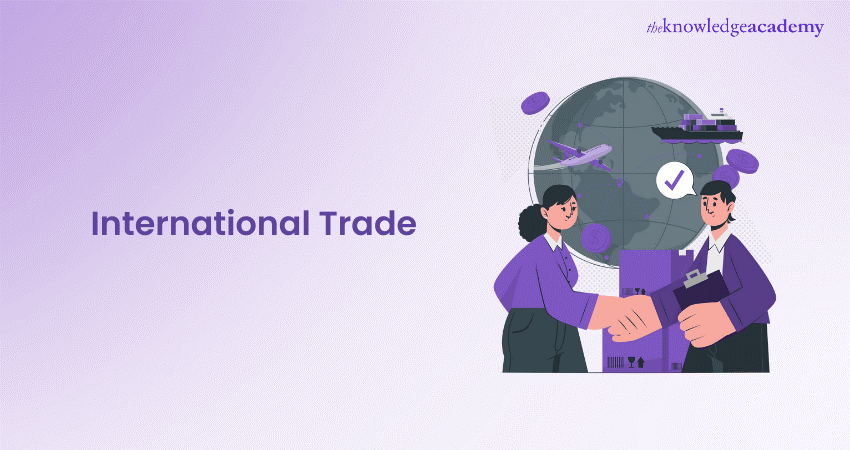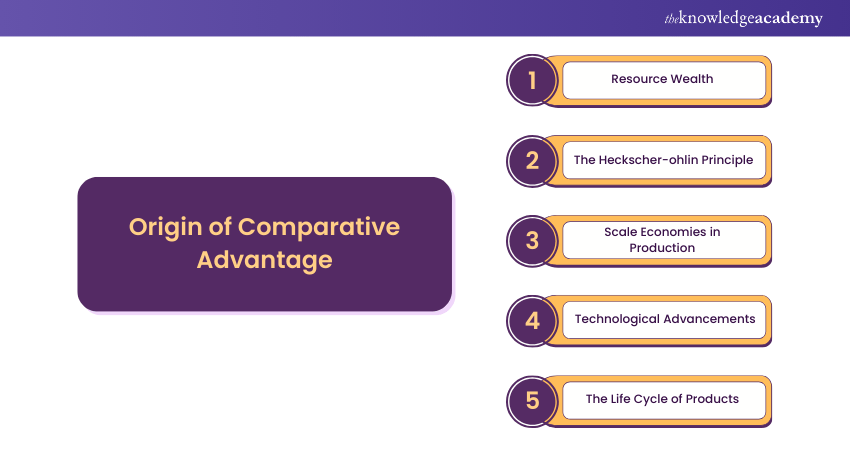We may not have the course you’re looking for. If you enquire or give us a call on +44 1344 203 999 and speak to our training experts, we may still be able to help with your training requirements.
We ensure quality, budget-alignment, and timely delivery by our expert instructors.

If you are starting as a new entrepreneur or want to expand your business beyond your country, you need to be aware and know everything about International Trade. But What is International Trade? It can be defined as an intricate network of transactions which transcends borders, connects economies and fosters interdependence.
Are you planning to begin your journey in this form of business? If you are, remember the factors influencing this trade are tariffs, trade agreements, and geopolitical influences. In this blog, we will help you through this process and help you understand more about What is International Trade, its advantages, policies and more!
Table of Contents
1) What is International Trade?
2) Imports & Exports
3) What is Comparative Advantage?
4) What are the Three Types of International Trade?
5) What are the Five Methods of International Trade?
6) Conclusion
What is International Trade?
International trade involves the exchange of goods or services between different countries. These exchanges can be either imports, which are goods or services brought into a country, or exports, which are goods or services sold to other countries.
This type of trade is a key aspect of economic interaction between nations and is a prime example of economic linkage. Other forms of economic linkages include foreign financial investments, multinational corporations, and the employment of foreign workers. The expansion of these economic connections is what we refer to as globalisation.
Imports & Exports
Ever wondered how your favourite coffee beans from Brazil end up in your morning cup or why tech gadgets from China dominate the market? That’s the power of imports and exports.
Here’s how it works:
a) Exports: When a country sells its products to the global market, it’s called an export.
b) Imports: When a country buys products from the global market, it’s an import.
These transactions are recorded in a country’s balance of payments, which acts like a report card for its economy.
Why is global trade important?
a) Different countries, have different strengths: Some have abundant natural resources, while others excel in technology or manufacturing.
b) Efficiency boost: Countries that produce certain goods faster and cheaper (thanks to resources, technology, or labour) can sell them at competitive prices.
c) Specialisation is key: If a country isn’t efficient at making something, it can trade with one that is.
In short, global trade allows countries to focus on what they do best while still gaining access to everything they need. It’s an interconnected system that keeps economies running and industries growing.
What is Comparative Advantage?
Comparative advantage explains why countries benefit from specialising in what they do best and trading for the rest. It’s like teamwork—everyone wins by focusing on strengths!
The Concept in Action
Countries have different resources and skills, making some goods cheaper to produce than others. Instead of making everything, they specialise and trade, saving costs and boosting efficiency.
England & Portugal Example
a) Portugal excels at making wine.
b) England is better at producing cloth.
c) By specialising and trading, both get more for less effort.
Why Trade Works
a) Specialisation maximises efficiency and reduces costs.
b) Trading ensures both nations access what they need at lower costs.
Comparative vs Absolute Advantage
a) Absolute advantage: A country is the best at something.
b) Comparative advantage: A country produces at a lower opportunity cost.
Even countries without absolute advantage gain from trade by focusing on their strengths. That’s the power of comparative advantage!
Origin of Comparative Advantage
Now, let’s discuss the origin of comparative advantage:

1) Resource Wealth
Comparative advantage originates in a country's abundance of natural resources. Nations endowed with rich resources, whether in minerals, agriculture, or energy, can produce certain goods more efficiently than others. This advantage stems from favourable conditions like fertile soil for agriculture, access to raw materials, or natural resource deposits, allowing these nations to specialise in producing specific goods and trade them for products they might not have as efficiently.
2) Factor Endowments: The Heckscher-Ohlin Principle
The Heckscher-Ohlin Principle, a key component of comparative advantage theory, asserts that countries will specialise in and export goods that intensively use the factors of production they have in abundance. This concept ties into factor endowments, such as labour, capital, and land. For instance, a labour-abundant country might specialise in labour-intensive industries, while a capital-rich nation might focus on capital-intensive production. This specialisation increases efficiency and fosters trade based on each country's relative factor endowments.
3) Scale Economies in Production
Another source of comparative advantage arises from economies of scale. When a country can produce a particular good at a larger scale, the average cost of production decreases. This efficiency allows for cost-effective production, making the country more competitive globally. Economies of scale are particularly evident in industries where high production volumes lead to lower average costs per unit, giving nations with larger markets a comparative advantage in these sectors.
4) Technological Advancements
Technological advancements contribute significantly to a country's comparative advantage. Nations at the forefront of technological innovation can produce goods more efficiently, often leading to higher-quality products at lower costs. Access to advanced technology allows countries to stay competitive by continuously improving production processes and creating innovative products. This advantage is dynamic, as staying technologically competitive requires ongoing investment in research and development.
5) The Life Cycle of Products
The life cycle of products also plays a role in determining comparative advantage. As products move through their life cycles—introduction, growth, maturity, and decline—different countries may have benefits at different stages. For example, innovation and adaptability are crucial during the introduction and growth phases, and countries with advanced research capabilities may have a comparative advantage. In the maturity phase, cost efficiency becomes more critical, and countries with effective production processes and economies of scale may take the lead. Understanding the life cycle of products allows nations to position themselves in global markets strategically.
What are the Three Types of International Trade?
International trade connects economies by enabling countries to access resources and expand markets, and it typically falls into three categories. Import trade occurs when a country buys goods or services it cannot efficiently produce, like the UK importing coffee from Brazil. Export trade involves selling goods or services to other nations, boosting the economy and job creation, such as Germany exporting luxury cars or India exporting IT services. Finally, entrepôt trade refers to importing goods, processing or repackaging them, and then exporting them to other countries, as seen with Singapore refining raw materials for global distribution.
What are the Five Methods of International Trade?
In global trade, selecting the right payment method balances security and flexibility. Here are the five key methods:
1) Cash in Advance – Safest for exporters, but least favourable for importers; payment is upfront before shipment.
2) Letter of Credit (LC) – A bank guarantees payment once conditions are met, reducing risk for both parties.
3) Documentary Collection (Drafts) – Payment isn’t guaranteed, but banks facilitate the process; ideal for trusted partners.
4) Open Account – Convenient for importers but risky for exporters, who ship before payment, often with credit terms.
5) Consignment – Riskiest for exporters; payment is made only after goods are sold, often in trust-based industries.
The method chosen depends on trust, transaction size, and risk tolerance, with proper agreements ensuring smooth transactions.
Enhance your knowledge of the current trends and policies with our Industry Training!
Conclusion
We hope you understood the basic concept of What is International Trade and why it is necessary to take your business beyond your country’s waters. In today’s world, it is a dynamic force shaping the global economy. It fosters economic interdependence, promotes efficiency through specialisation, and drives innovation.
Enhance your knowledge about managing Supply Chain – sign up now for our Supply Chain Management Training!
Frequently Asked Questions
What Are the Benefits of International Trade for a Business?

International Trade allows businesses to expand their markets, increase revenue, and access new customers. It also helps companies to source raw materials at lower costs, diversify risks, and stay competitive. Additionally, global trade fosters innovation and growth by exposing businesses to new ideas, technologies, and partnerships.
What are Some of the Examples of International Trade Policies?

International Trade policies regulate global commerce through tariffs, quotas, and trade agreements. Examples include Free Trade Agreements (FTAs) like NAFTA (now USMCA), tariff policies such as the EU’s Common External Tariff, and sanctions like those imposed on restricted nations. These policies shape global trade by influencing costs, supply chains, and market access.
What are the Other Resources and Offers Provided by The Knowledge Academy?

The Knowledge Academy takes global learning to new heights, offering over 3,000 online courses across 490+ locations in 190+ countries. This expansive reach ensures accessibility and convenience for learners worldwide.
Alongside our diverse Online Course Catalogue, encompassing 19 major categories, we go the extra mile by providing a plethora of free educational Online Resources like News updates, Blogs, videos, webinars, and interview questions. Tailoring learning experiences further, professionals can maximise value with customisable Course Bundles of TKA.
What is The Knowledge Pass, and How Does it Work?

The Knowledge Academy’s Knowledge Pass, a prepaid voucher, adds another layer of flexibility, allowing course bookings over a 12-month period. Join us on a journey where education knows no bounds.
What are related Industry courses and blogs provided by The Knowledge Academy?

The Knowledge Academy offers various Industry Training, including Facilities Management Training, Product Management Training and Supply Chain Management Training. These courses cater to different skill levels, providing comprehensive insights into Facility Management.
Our Business Skills Blogs cover a range of topics related to Facilities Management, offering valuable resources, best practices, and industry insights. Whether you are a beginner or looking to advance your Facilities Asset Management skills, The Knowledge Academy's diverse courses and informative blogs have got you covered.
Upcoming Business Skills Resources Batches & Dates
Date
 Import Export Course
Import Export Course
Fri 4th Apr 2025
Fri 6th Jun 2025
Fri 8th Aug 2025
Fri 3rd Oct 2025
Fri 5th Dec 2025






 Top Rated Course
Top Rated Course



 If you wish to make any changes to your course, please
If you wish to make any changes to your course, please


